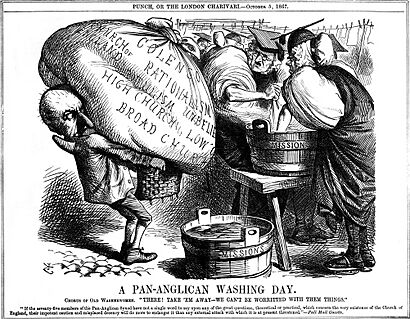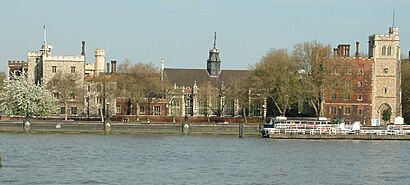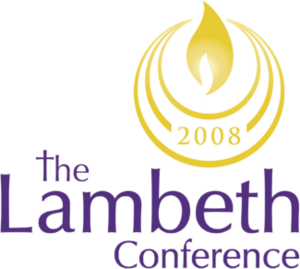Lambeth Conference facts for kids
The Lambeth Conference is a major meeting of bishops from the Anglican Christian faith. The Archbishop of Canterbury, the senior bishop in the Church of England, calls for this meeting about once every ten years. The very first conference was held in Lambeth, a part of London, in 1867.
These conferences are a way for church leaders from all over the world to come together. They discuss important issues and share ideas. The decisions they make are not laws, but they are very influential. They help guide the Anglican churches in different countries.
The Lambeth Conferences are one of the four main ways the global Anglican Communion stays connected. These are known as the Instruments of Communion.
Contents
How the Conference Began
The idea for a global meeting of bishops came from Bishop John Henry Hopkins from Vermont, USA, in 1851. However, the real push came from church leaders in Canada. In 1865, they were worried that their church might start to drift away from the Church of England. They wrote a letter to the Archbishop of Canterbury, Charles Thomas Longley.
They asked him to call a meeting of all Anglican bishops from around the world. Archbishop Longley agreed. He invited all 144 Anglican bishops to meet at Lambeth Palace in 1867.
Not everyone liked the idea at first. Some important bishops, including the Archbishop of York, chose not to attend. They were worried it might cause confusion. But Archbishop Longley explained that the meeting was not to make new laws. It was to discuss practical matters and offer guidance.
Over time, the resolutions passed at the conferences became more and more respected.
The First Meetings
The first conference in 1867 had 76 bishops. They met in private for four days. They discussed issues, formed committees, and wrote a letter to all members of the Anglican Communion. Since then, each conference has started with a special service in Canterbury Cathedral.
Starting with the second conference, the meetings were held at Lambeth Palace. From 1978, the conference moved to the University of Kent campus in Canterbury. This allowed the bishops and their spouses to live, work, and worship together in one place.
Key Conferences Through the Years
Early Conferences (1867–1897)

- 1867: The first conference, led by Archbishop Charles Thomas Longley, had 76 bishops. A major topic was the situation in the Diocese of Natal, where Bishop John William Colenso had views that were different from the church's main teachings.
- 1878: 100 bishops attended this meeting, led by Archbishop Archibald Campbell Tait. They discussed how to maintain unity and deal with modern ideas.
- 1888: Led by Archbishop Edward White Benson, 145 bishops met. They discussed social issues like caring for people who moved to new countries. They also adopted the Chicago-Lambeth Quadrilateral. This was a four-point guide for unity between different Christian churches.
- 1897: This conference had 194 bishops. It was held a year early to celebrate the 1300th anniversary of St. Augustine's arrival in England.
20th Century Developments
- 1908: Archbishop Randall Davidson led this conference with 242 bishops. They talked about faith, education, and missions abroad.
- 1920: After World War I, 252 bishops met. They issued an "Appeal to all Christian People," inviting other churches to work towards unity. They also supported the role of women as lay members in church leadership.
- 1930: Led by Archbishop Cosmo Gordon Lang, 308 bishops attended. They discussed world peace and supported the League of Nations. They also affirmed that people of all races should be welcomed in any church.
- 1948: After World War II, Archbishop Geoffrey Fisher led a meeting of 349 bishops. They welcomed full communion with Old Catholic churches. They also stated that discriminating against people because of their race was against Christian principles.
- 1958: This conference, with 310 bishops, discussed family life and recommended considering bringing back the role of the permanent deacon.
- 1968: Led by Archbishop Michael Ramsey, 462 bishops met. For the first time, the meeting was held at Church House, Westminster, because of the large number of attendees. They recommended that women could be ordained as deacons.
- 1978: 440 bishops attended. The conference, led by Archbishop Donald Coggan, recognized that each member church had the right to make its own decision about ordaining women as priests. It also spoke out against the death penalty.
- 1988: Archbishop Robert Runcie led a meeting of 518 bishops. For the first time, a female priest, The Reverend Nan Arrington Peete, spoke at the conference. They discussed human rights, poverty, and protecting the environment.
- 1998: This conference, led by Archbishop George Carey, had 749 bishops, including 11 women bishops for the first time. A major topic was a disagreement over modern social issues, which led to a lot of debate.
21st Century Conferences
- 2008: Archbishop Rowan Williams presided over this conference. About 670 bishops attended. The focus was on training for mission and prayer. However, disagreements from the 1998 conference continued. Some bishops, mainly from Africa, chose not to attend in protest. During the final service, seven martyred members of the Melanesian Brotherhood were honored.
- 2022: The most recent conference was led by Archbishop Justin Welby. It was planned for 2020 but was delayed due to the COVID-19 pandemic. Around 660 bishops attended. The theme was "God's Church to God's World." Debates over social issues continued to be a major point of discussion among the bishops.
Images for kids



